The Environmental Impact of Nappies: A Comprehensive Analysis
VerifiedAdded on 2021/02/21
|10
|3100
|30
Report
AI Summary
This report delves into the environmental consequences of disposable nappies, commonly used worldwide. It highlights that these non-biodegradable products take approximately 100 years to decompose, posing a significant threat to the environment. The report examines the problem statement, rationale, and research questions related to the environmental impact of nappies. It explores the life cycle of nappies, from manufacturing to disposal, and discusses the pollution caused by them. The methodology includes a qualitative research approach, analyzing secondary sources like articles and reports. The findings emphasize the need for sustainable alternatives, such as cloth nappies, while acknowledging the challenges associated with their use. The report concludes by stressing the urgent need for environmentally friendly solutions to mitigate the negative effects of nappies on the planet.
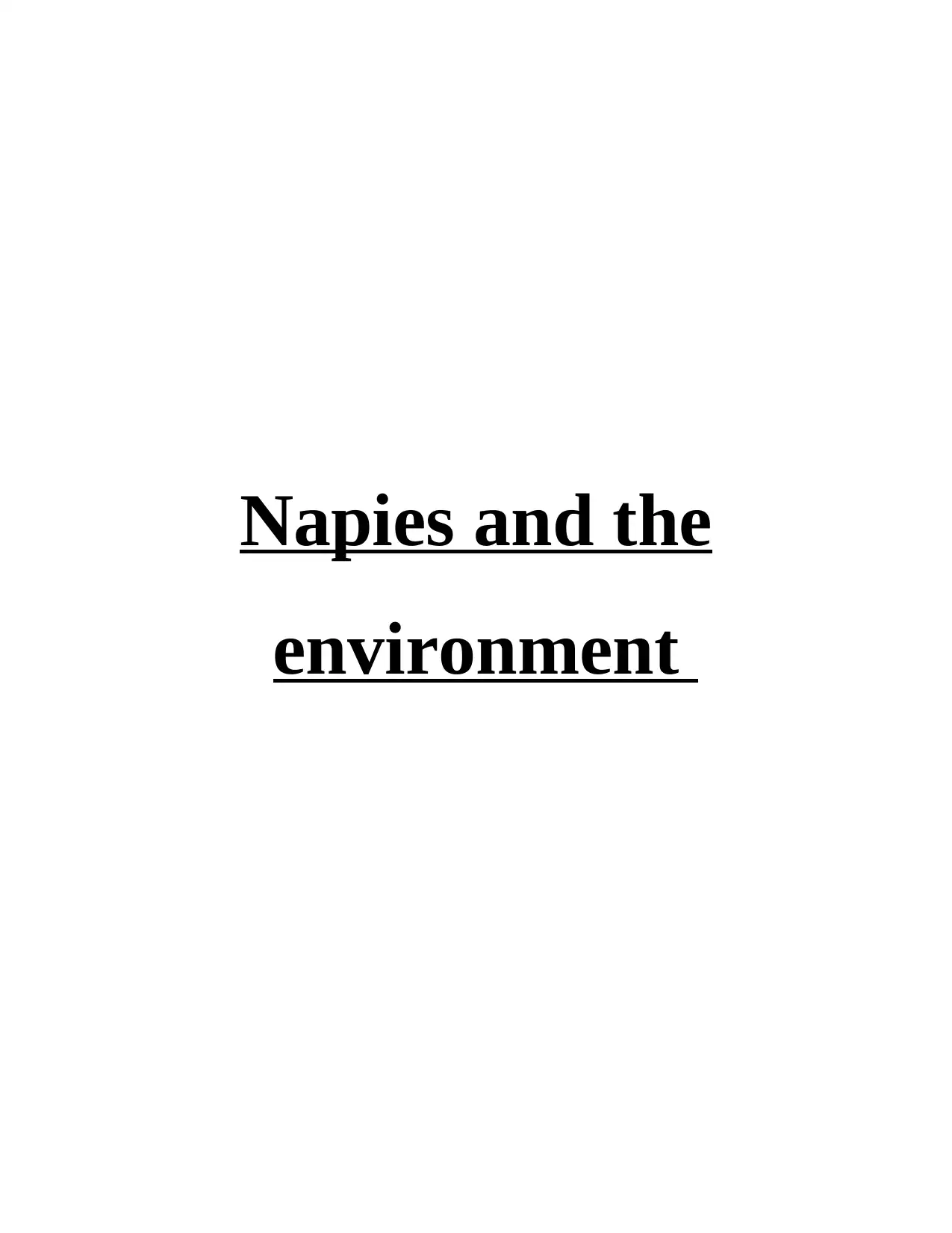
Napies and the
environment
environment
Paraphrase This Document
Need a fresh take? Get an instant paraphrase of this document with our AI Paraphraser
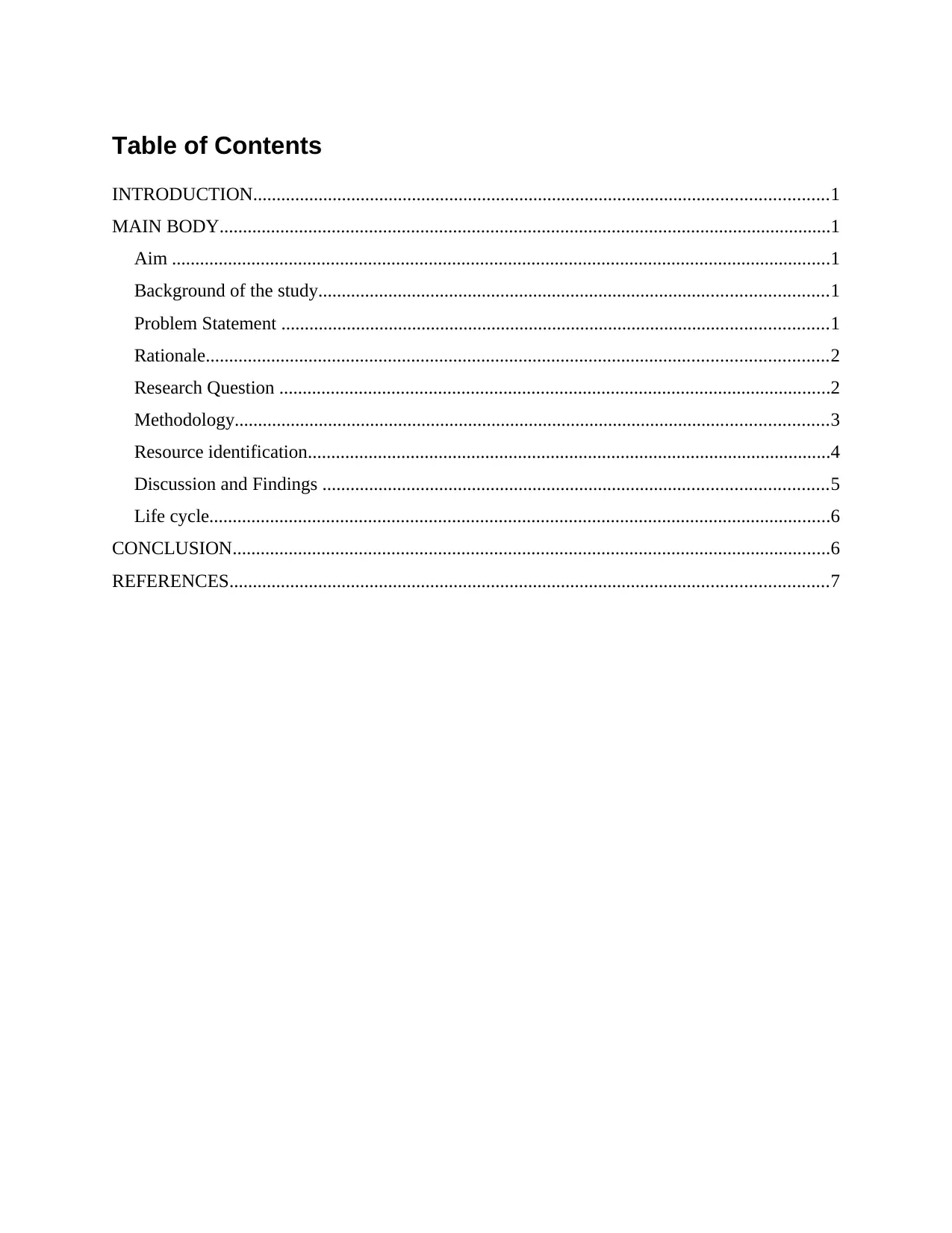
Table of Contents
INTRODUCTION...........................................................................................................................1
MAIN BODY...................................................................................................................................1
Aim .............................................................................................................................................1
Background of the study.............................................................................................................1
Problem Statement .....................................................................................................................1
Rationale.....................................................................................................................................2
Research Question ......................................................................................................................2
Methodology...............................................................................................................................3
Resource identification................................................................................................................4
Discussion and Findings ............................................................................................................5
Life cycle.....................................................................................................................................6
CONCLUSION................................................................................................................................6
REFERENCES................................................................................................................................7
INTRODUCTION...........................................................................................................................1
MAIN BODY...................................................................................................................................1
Aim .............................................................................................................................................1
Background of the study.............................................................................................................1
Problem Statement .....................................................................................................................1
Rationale.....................................................................................................................................2
Research Question ......................................................................................................................2
Methodology...............................................................................................................................3
Resource identification................................................................................................................4
Discussion and Findings ............................................................................................................5
Life cycle.....................................................................................................................................6
CONCLUSION................................................................................................................................6
REFERENCES................................................................................................................................7
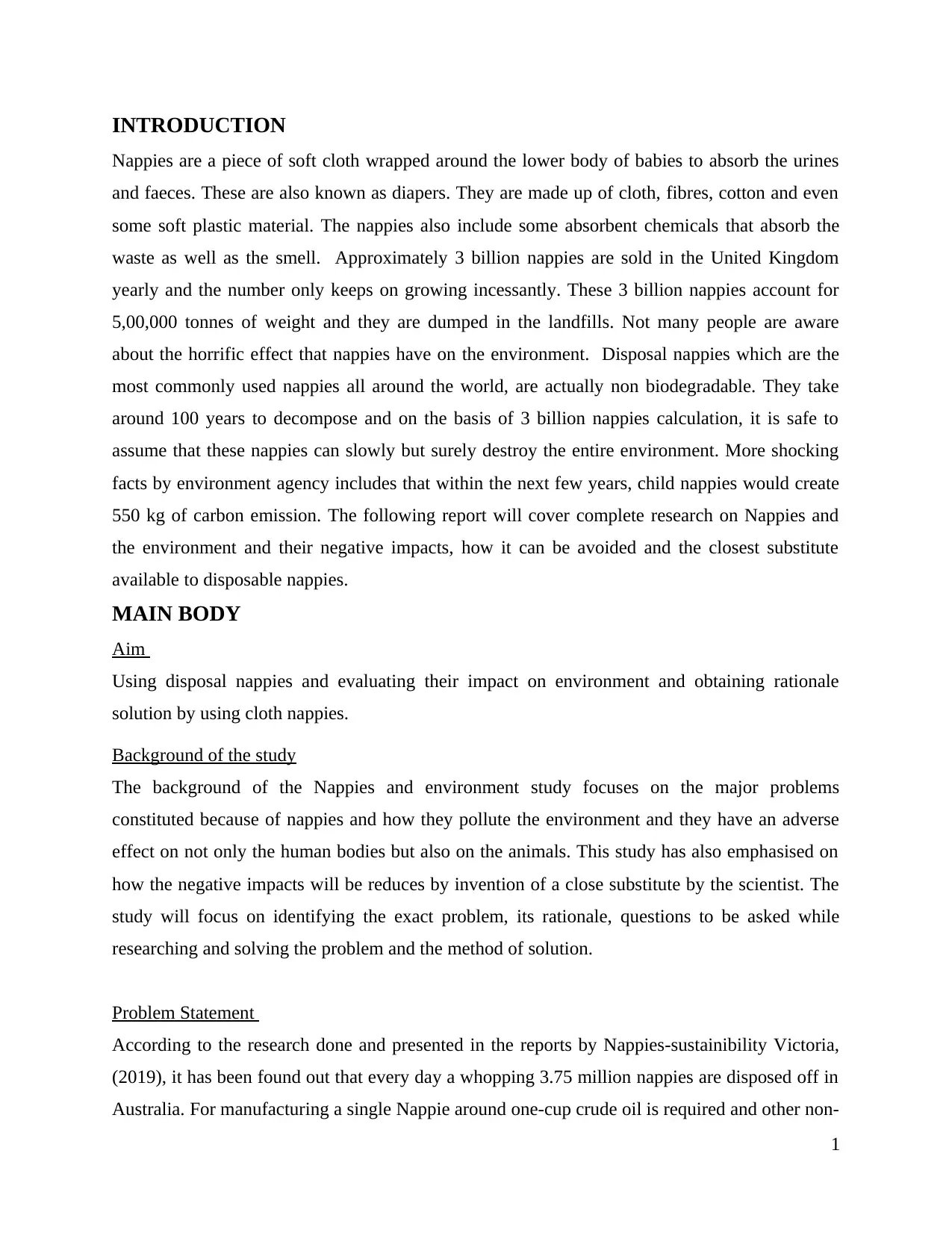
INTRODUCTION
Nappies are a piece of soft cloth wrapped around the lower body of babies to absorb the urines
and faeces. These are also known as diapers. They are made up of cloth, fibres, cotton and even
some soft plastic material. The nappies also include some absorbent chemicals that absorb the
waste as well as the smell. Approximately 3 billion nappies are sold in the United Kingdom
yearly and the number only keeps on growing incessantly. These 3 billion nappies account for
5,00,000 tonnes of weight and they are dumped in the landfills. Not many people are aware
about the horrific effect that nappies have on the environment. Disposal nappies which are the
most commonly used nappies all around the world, are actually non biodegradable. They take
around 100 years to decompose and on the basis of 3 billion nappies calculation, it is safe to
assume that these nappies can slowly but surely destroy the entire environment. More shocking
facts by environment agency includes that within the next few years, child nappies would create
550 kg of carbon emission. The following report will cover complete research on Nappies and
the environment and their negative impacts, how it can be avoided and the closest substitute
available to disposable nappies.
MAIN BODY
Aim
Using disposal nappies and evaluating their impact on environment and obtaining rationale
solution by using cloth nappies.
Background of the study
The background of the Nappies and environment study focuses on the major problems
constituted because of nappies and how they pollute the environment and they have an adverse
effect on not only the human bodies but also on the animals. This study has also emphasised on
how the negative impacts will be reduces by invention of a close substitute by the scientist. The
study will focus on identifying the exact problem, its rationale, questions to be asked while
researching and solving the problem and the method of solution.
Problem Statement
According to the research done and presented in the reports by Nappies-sustainibility Victoria,
(2019), it has been found out that every day a whopping 3.75 million nappies are disposed off in
Australia. For manufacturing a single Nappie around one-cup crude oil is required and other non-
1
Nappies are a piece of soft cloth wrapped around the lower body of babies to absorb the urines
and faeces. These are also known as diapers. They are made up of cloth, fibres, cotton and even
some soft plastic material. The nappies also include some absorbent chemicals that absorb the
waste as well as the smell. Approximately 3 billion nappies are sold in the United Kingdom
yearly and the number only keeps on growing incessantly. These 3 billion nappies account for
5,00,000 tonnes of weight and they are dumped in the landfills. Not many people are aware
about the horrific effect that nappies have on the environment. Disposal nappies which are the
most commonly used nappies all around the world, are actually non biodegradable. They take
around 100 years to decompose and on the basis of 3 billion nappies calculation, it is safe to
assume that these nappies can slowly but surely destroy the entire environment. More shocking
facts by environment agency includes that within the next few years, child nappies would create
550 kg of carbon emission. The following report will cover complete research on Nappies and
the environment and their negative impacts, how it can be avoided and the closest substitute
available to disposable nappies.
MAIN BODY
Aim
Using disposal nappies and evaluating their impact on environment and obtaining rationale
solution by using cloth nappies.
Background of the study
The background of the Nappies and environment study focuses on the major problems
constituted because of nappies and how they pollute the environment and they have an adverse
effect on not only the human bodies but also on the animals. This study has also emphasised on
how the negative impacts will be reduces by invention of a close substitute by the scientist. The
study will focus on identifying the exact problem, its rationale, questions to be asked while
researching and solving the problem and the method of solution.
Problem Statement
According to the research done and presented in the reports by Nappies-sustainibility Victoria,
(2019), it has been found out that every day a whopping 3.75 million nappies are disposed off in
Australia. For manufacturing a single Nappie around one-cup crude oil is required and other non-
1
⊘ This is a preview!⊘
Do you want full access?
Subscribe today to unlock all pages.

Trusted by 1+ million students worldwide
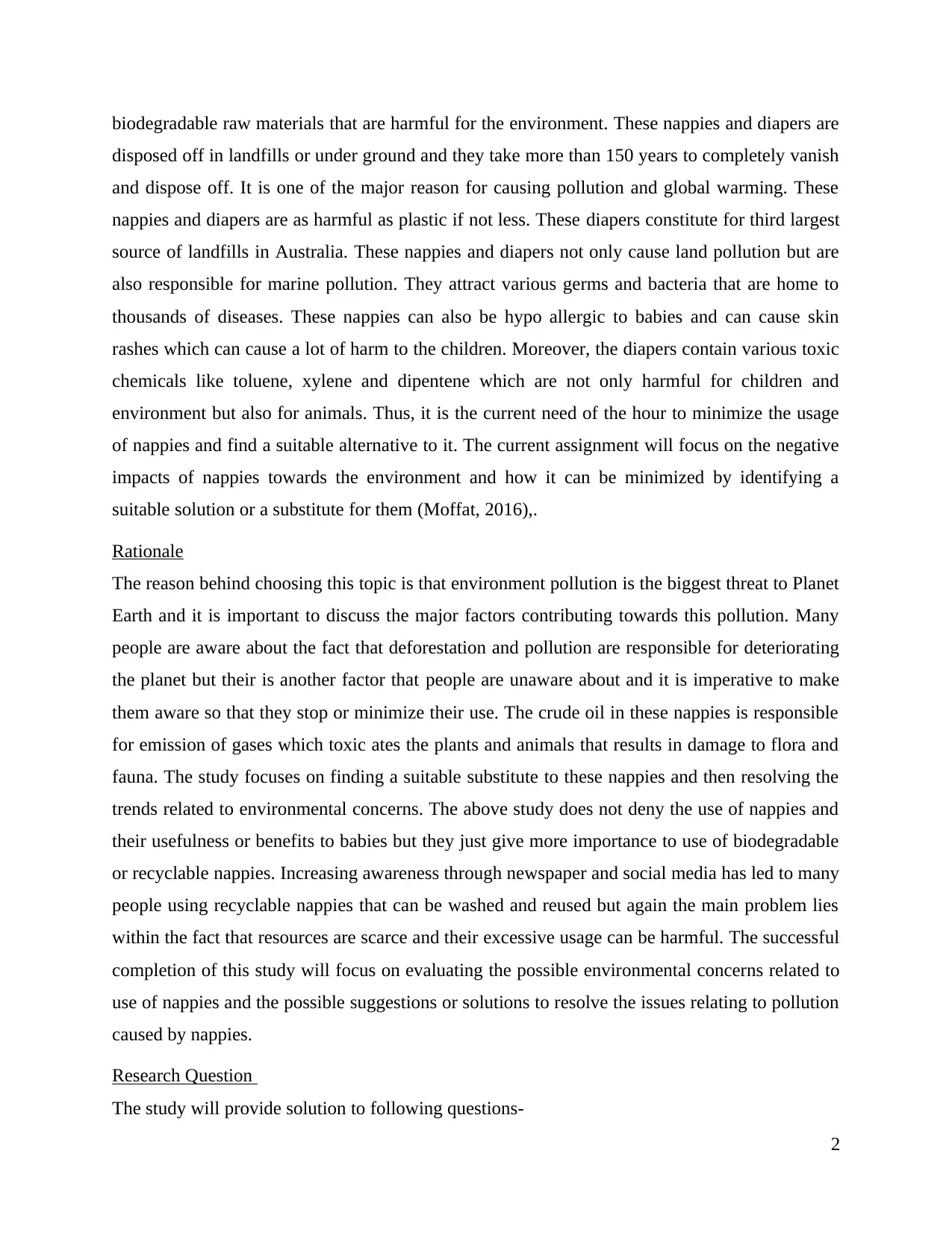
biodegradable raw materials that are harmful for the environment. These nappies and diapers are
disposed off in landfills or under ground and they take more than 150 years to completely vanish
and dispose off. It is one of the major reason for causing pollution and global warming. These
nappies and diapers are as harmful as plastic if not less. These diapers constitute for third largest
source of landfills in Australia. These nappies and diapers not only cause land pollution but are
also responsible for marine pollution. They attract various germs and bacteria that are home to
thousands of diseases. These nappies can also be hypo allergic to babies and can cause skin
rashes which can cause a lot of harm to the children. Moreover, the diapers contain various toxic
chemicals like toluene, xylene and dipentene which are not only harmful for children and
environment but also for animals. Thus, it is the current need of the hour to minimize the usage
of nappies and find a suitable alternative to it. The current assignment will focus on the negative
impacts of nappies towards the environment and how it can be minimized by identifying a
suitable solution or a substitute for them (Moffat, 2016),.
Rationale
The reason behind choosing this topic is that environment pollution is the biggest threat to Planet
Earth and it is important to discuss the major factors contributing towards this pollution. Many
people are aware about the fact that deforestation and pollution are responsible for deteriorating
the planet but their is another factor that people are unaware about and it is imperative to make
them aware so that they stop or minimize their use. The crude oil in these nappies is responsible
for emission of gases which toxic ates the plants and animals that results in damage to flora and
fauna. The study focuses on finding a suitable substitute to these nappies and then resolving the
trends related to environmental concerns. The above study does not deny the use of nappies and
their usefulness or benefits to babies but they just give more importance to use of biodegradable
or recyclable nappies. Increasing awareness through newspaper and social media has led to many
people using recyclable nappies that can be washed and reused but again the main problem lies
within the fact that resources are scarce and their excessive usage can be harmful. The successful
completion of this study will focus on evaluating the possible environmental concerns related to
use of nappies and the possible suggestions or solutions to resolve the issues relating to pollution
caused by nappies.
Research Question
The study will provide solution to following questions-
2
disposed off in landfills or under ground and they take more than 150 years to completely vanish
and dispose off. It is one of the major reason for causing pollution and global warming. These
nappies and diapers are as harmful as plastic if not less. These diapers constitute for third largest
source of landfills in Australia. These nappies and diapers not only cause land pollution but are
also responsible for marine pollution. They attract various germs and bacteria that are home to
thousands of diseases. These nappies can also be hypo allergic to babies and can cause skin
rashes which can cause a lot of harm to the children. Moreover, the diapers contain various toxic
chemicals like toluene, xylene and dipentene which are not only harmful for children and
environment but also for animals. Thus, it is the current need of the hour to minimize the usage
of nappies and find a suitable alternative to it. The current assignment will focus on the negative
impacts of nappies towards the environment and how it can be minimized by identifying a
suitable solution or a substitute for them (Moffat, 2016),.
Rationale
The reason behind choosing this topic is that environment pollution is the biggest threat to Planet
Earth and it is important to discuss the major factors contributing towards this pollution. Many
people are aware about the fact that deforestation and pollution are responsible for deteriorating
the planet but their is another factor that people are unaware about and it is imperative to make
them aware so that they stop or minimize their use. The crude oil in these nappies is responsible
for emission of gases which toxic ates the plants and animals that results in damage to flora and
fauna. The study focuses on finding a suitable substitute to these nappies and then resolving the
trends related to environmental concerns. The above study does not deny the use of nappies and
their usefulness or benefits to babies but they just give more importance to use of biodegradable
or recyclable nappies. Increasing awareness through newspaper and social media has led to many
people using recyclable nappies that can be washed and reused but again the main problem lies
within the fact that resources are scarce and their excessive usage can be harmful. The successful
completion of this study will focus on evaluating the possible environmental concerns related to
use of nappies and the possible suggestions or solutions to resolve the issues relating to pollution
caused by nappies.
Research Question
The study will provide solution to following questions-
2
Paraphrase This Document
Need a fresh take? Get an instant paraphrase of this document with our AI Paraphraser
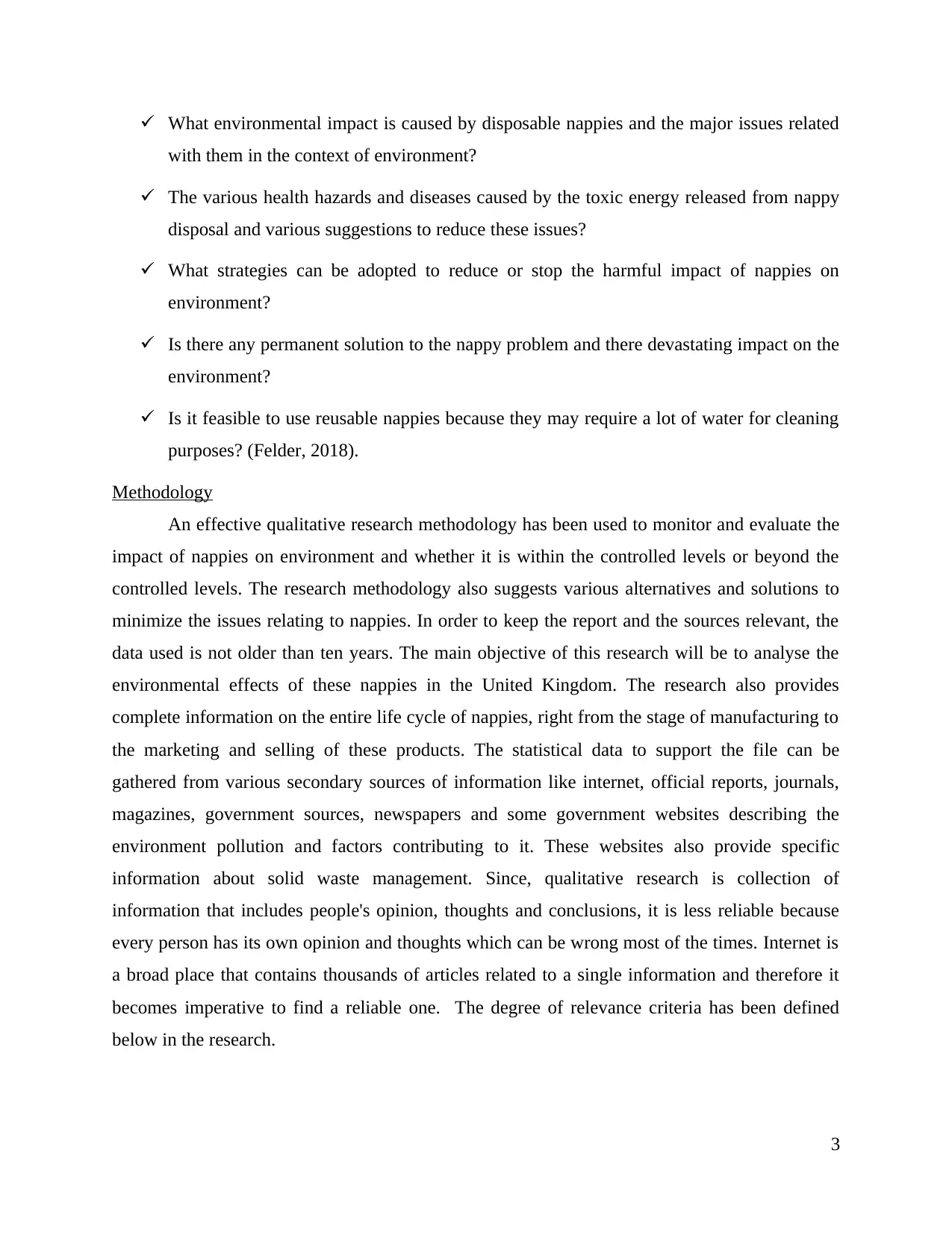
What environmental impact is caused by disposable nappies and the major issues related
with them in the context of environment?
The various health hazards and diseases caused by the toxic energy released from nappy
disposal and various suggestions to reduce these issues?
What strategies can be adopted to reduce or stop the harmful impact of nappies on
environment?
Is there any permanent solution to the nappy problem and there devastating impact on the
environment?
Is it feasible to use reusable nappies because they may require a lot of water for cleaning
purposes? (Felder, 2018).
Methodology
An effective qualitative research methodology has been used to monitor and evaluate the
impact of nappies on environment and whether it is within the controlled levels or beyond the
controlled levels. The research methodology also suggests various alternatives and solutions to
minimize the issues relating to nappies. In order to keep the report and the sources relevant, the
data used is not older than ten years. The main objective of this research will be to analyse the
environmental effects of these nappies in the United Kingdom. The research also provides
complete information on the entire life cycle of nappies, right from the stage of manufacturing to
the marketing and selling of these products. The statistical data to support the file can be
gathered from various secondary sources of information like internet, official reports, journals,
magazines, government sources, newspapers and some government websites describing the
environment pollution and factors contributing to it. These websites also provide specific
information about solid waste management. Since, qualitative research is collection of
information that includes people's opinion, thoughts and conclusions, it is less reliable because
every person has its own opinion and thoughts which can be wrong most of the times. Internet is
a broad place that contains thousands of articles related to a single information and therefore it
becomes imperative to find a reliable one. The degree of relevance criteria has been defined
below in the research.
3
with them in the context of environment?
The various health hazards and diseases caused by the toxic energy released from nappy
disposal and various suggestions to reduce these issues?
What strategies can be adopted to reduce or stop the harmful impact of nappies on
environment?
Is there any permanent solution to the nappy problem and there devastating impact on the
environment?
Is it feasible to use reusable nappies because they may require a lot of water for cleaning
purposes? (Felder, 2018).
Methodology
An effective qualitative research methodology has been used to monitor and evaluate the
impact of nappies on environment and whether it is within the controlled levels or beyond the
controlled levels. The research methodology also suggests various alternatives and solutions to
minimize the issues relating to nappies. In order to keep the report and the sources relevant, the
data used is not older than ten years. The main objective of this research will be to analyse the
environmental effects of these nappies in the United Kingdom. The research also provides
complete information on the entire life cycle of nappies, right from the stage of manufacturing to
the marketing and selling of these products. The statistical data to support the file can be
gathered from various secondary sources of information like internet, official reports, journals,
magazines, government sources, newspapers and some government websites describing the
environment pollution and factors contributing to it. These websites also provide specific
information about solid waste management. Since, qualitative research is collection of
information that includes people's opinion, thoughts and conclusions, it is less reliable because
every person has its own opinion and thoughts which can be wrong most of the times. Internet is
a broad place that contains thousands of articles related to a single information and therefore it
becomes imperative to find a reliable one. The degree of relevance criteria has been defined
below in the research.
3
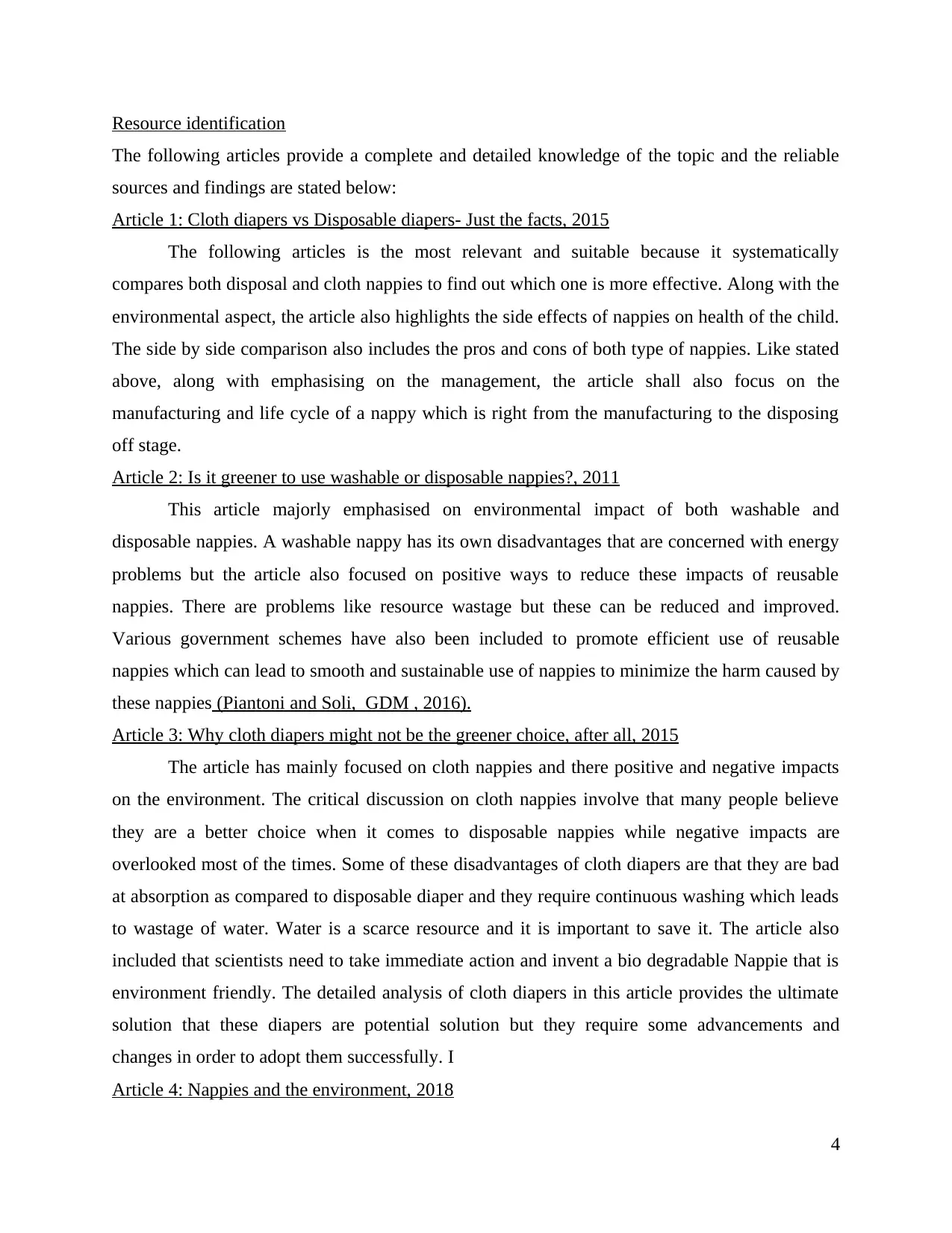
Resource identification
The following articles provide a complete and detailed knowledge of the topic and the reliable
sources and findings are stated below:
Article 1: Cloth diapers vs Disposable diapers- Just the facts, 2015
The following articles is the most relevant and suitable because it systematically
compares both disposal and cloth nappies to find out which one is more effective. Along with the
environmental aspect, the article also highlights the side effects of nappies on health of the child.
The side by side comparison also includes the pros and cons of both type of nappies. Like stated
above, along with emphasising on the management, the article shall also focus on the
manufacturing and life cycle of a nappy which is right from the manufacturing to the disposing
off stage.
Article 2: Is it greener to use washable or disposable nappies?, 2011
This article majorly emphasised on environmental impact of both washable and
disposable nappies. A washable nappy has its own disadvantages that are concerned with energy
problems but the article also focused on positive ways to reduce these impacts of reusable
nappies. There are problems like resource wastage but these can be reduced and improved.
Various government schemes have also been included to promote efficient use of reusable
nappies which can lead to smooth and sustainable use of nappies to minimize the harm caused by
these nappies (Piantoni and Soli, GDM , 2016).
Article 3: Why cloth diapers might not be the greener choice, after all, 2015
The article has mainly focused on cloth nappies and there positive and negative impacts
on the environment. The critical discussion on cloth nappies involve that many people believe
they are a better choice when it comes to disposable nappies while negative impacts are
overlooked most of the times. Some of these disadvantages of cloth diapers are that they are bad
at absorption as compared to disposable diaper and they require continuous washing which leads
to wastage of water. Water is a scarce resource and it is important to save it. The article also
included that scientists need to take immediate action and invent a bio degradable Nappie that is
environment friendly. The detailed analysis of cloth diapers in this article provides the ultimate
solution that these diapers are potential solution but they require some advancements and
changes in order to adopt them successfully. I
Article 4: Nappies and the environment, 2018
4
The following articles provide a complete and detailed knowledge of the topic and the reliable
sources and findings are stated below:
Article 1: Cloth diapers vs Disposable diapers- Just the facts, 2015
The following articles is the most relevant and suitable because it systematically
compares both disposal and cloth nappies to find out which one is more effective. Along with the
environmental aspect, the article also highlights the side effects of nappies on health of the child.
The side by side comparison also includes the pros and cons of both type of nappies. Like stated
above, along with emphasising on the management, the article shall also focus on the
manufacturing and life cycle of a nappy which is right from the manufacturing to the disposing
off stage.
Article 2: Is it greener to use washable or disposable nappies?, 2011
This article majorly emphasised on environmental impact of both washable and
disposable nappies. A washable nappy has its own disadvantages that are concerned with energy
problems but the article also focused on positive ways to reduce these impacts of reusable
nappies. There are problems like resource wastage but these can be reduced and improved.
Various government schemes have also been included to promote efficient use of reusable
nappies which can lead to smooth and sustainable use of nappies to minimize the harm caused by
these nappies (Piantoni and Soli, GDM , 2016).
Article 3: Why cloth diapers might not be the greener choice, after all, 2015
The article has mainly focused on cloth nappies and there positive and negative impacts
on the environment. The critical discussion on cloth nappies involve that many people believe
they are a better choice when it comes to disposable nappies while negative impacts are
overlooked most of the times. Some of these disadvantages of cloth diapers are that they are bad
at absorption as compared to disposable diaper and they require continuous washing which leads
to wastage of water. Water is a scarce resource and it is important to save it. The article also
included that scientists need to take immediate action and invent a bio degradable Nappie that is
environment friendly. The detailed analysis of cloth diapers in this article provides the ultimate
solution that these diapers are potential solution but they require some advancements and
changes in order to adopt them successfully. I
Article 4: Nappies and the environment, 2018
4
⊘ This is a preview!⊘
Do you want full access?
Subscribe today to unlock all pages.

Trusted by 1+ million students worldwide
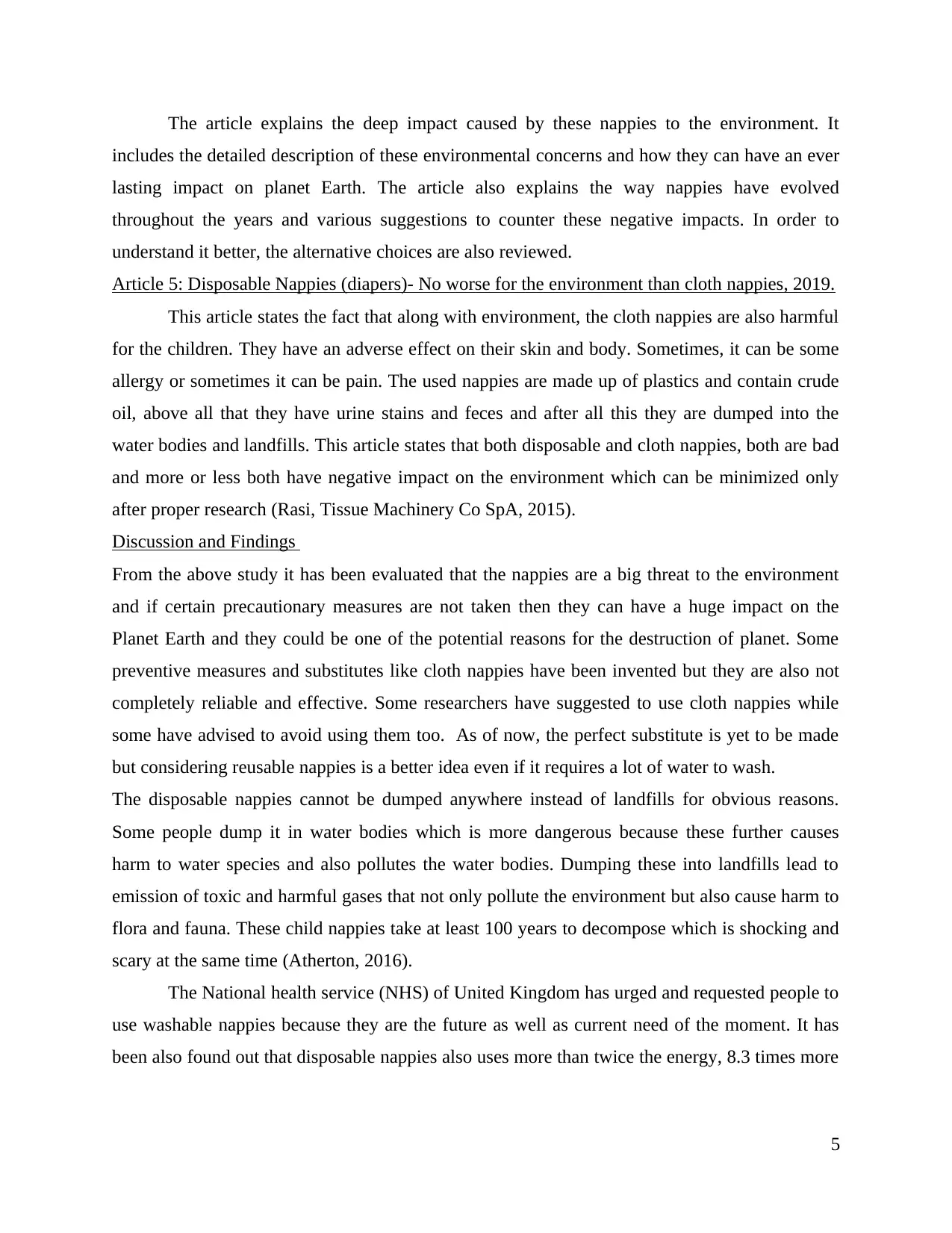
The article explains the deep impact caused by these nappies to the environment. It
includes the detailed description of these environmental concerns and how they can have an ever
lasting impact on planet Earth. The article also explains the way nappies have evolved
throughout the years and various suggestions to counter these negative impacts. In order to
understand it better, the alternative choices are also reviewed.
Article 5: Disposable Nappies (diapers)- No worse for the environment than cloth nappies, 2019.
This article states the fact that along with environment, the cloth nappies are also harmful
for the children. They have an adverse effect on their skin and body. Sometimes, it can be some
allergy or sometimes it can be pain. The used nappies are made up of plastics and contain crude
oil, above all that they have urine stains and feces and after all this they are dumped into the
water bodies and landfills. This article states that both disposable and cloth nappies, both are bad
and more or less both have negative impact on the environment which can be minimized only
after proper research (Rasi, Tissue Machinery Co SpA, 2015).
Discussion and Findings
From the above study it has been evaluated that the nappies are a big threat to the environment
and if certain precautionary measures are not taken then they can have a huge impact on the
Planet Earth and they could be one of the potential reasons for the destruction of planet. Some
preventive measures and substitutes like cloth nappies have been invented but they are also not
completely reliable and effective. Some researchers have suggested to use cloth nappies while
some have advised to avoid using them too. As of now, the perfect substitute is yet to be made
but considering reusable nappies is a better idea even if it requires a lot of water to wash.
The disposable nappies cannot be dumped anywhere instead of landfills for obvious reasons.
Some people dump it in water bodies which is more dangerous because these further causes
harm to water species and also pollutes the water bodies. Dumping these into landfills lead to
emission of toxic and harmful gases that not only pollute the environment but also cause harm to
flora and fauna. These child nappies take at least 100 years to decompose which is shocking and
scary at the same time (Atherton, 2016).
The National health service (NHS) of United Kingdom has urged and requested people to
use washable nappies because they are the future as well as current need of the moment. It has
been also found out that disposable nappies also uses more than twice the energy, 8.3 times more
5
includes the detailed description of these environmental concerns and how they can have an ever
lasting impact on planet Earth. The article also explains the way nappies have evolved
throughout the years and various suggestions to counter these negative impacts. In order to
understand it better, the alternative choices are also reviewed.
Article 5: Disposable Nappies (diapers)- No worse for the environment than cloth nappies, 2019.
This article states the fact that along with environment, the cloth nappies are also harmful
for the children. They have an adverse effect on their skin and body. Sometimes, it can be some
allergy or sometimes it can be pain. The used nappies are made up of plastics and contain crude
oil, above all that they have urine stains and feces and after all this they are dumped into the
water bodies and landfills. This article states that both disposable and cloth nappies, both are bad
and more or less both have negative impact on the environment which can be minimized only
after proper research (Rasi, Tissue Machinery Co SpA, 2015).
Discussion and Findings
From the above study it has been evaluated that the nappies are a big threat to the environment
and if certain precautionary measures are not taken then they can have a huge impact on the
Planet Earth and they could be one of the potential reasons for the destruction of planet. Some
preventive measures and substitutes like cloth nappies have been invented but they are also not
completely reliable and effective. Some researchers have suggested to use cloth nappies while
some have advised to avoid using them too. As of now, the perfect substitute is yet to be made
but considering reusable nappies is a better idea even if it requires a lot of water to wash.
The disposable nappies cannot be dumped anywhere instead of landfills for obvious reasons.
Some people dump it in water bodies which is more dangerous because these further causes
harm to water species and also pollutes the water bodies. Dumping these into landfills lead to
emission of toxic and harmful gases that not only pollute the environment but also cause harm to
flora and fauna. These child nappies take at least 100 years to decompose which is shocking and
scary at the same time (Atherton, 2016).
The National health service (NHS) of United Kingdom has urged and requested people to
use washable nappies because they are the future as well as current need of the moment. It has
been also found out that disposable nappies also uses more than twice the energy, 8.3 times more
5
Paraphrase This Document
Need a fresh take? Get an instant paraphrase of this document with our AI Paraphraser
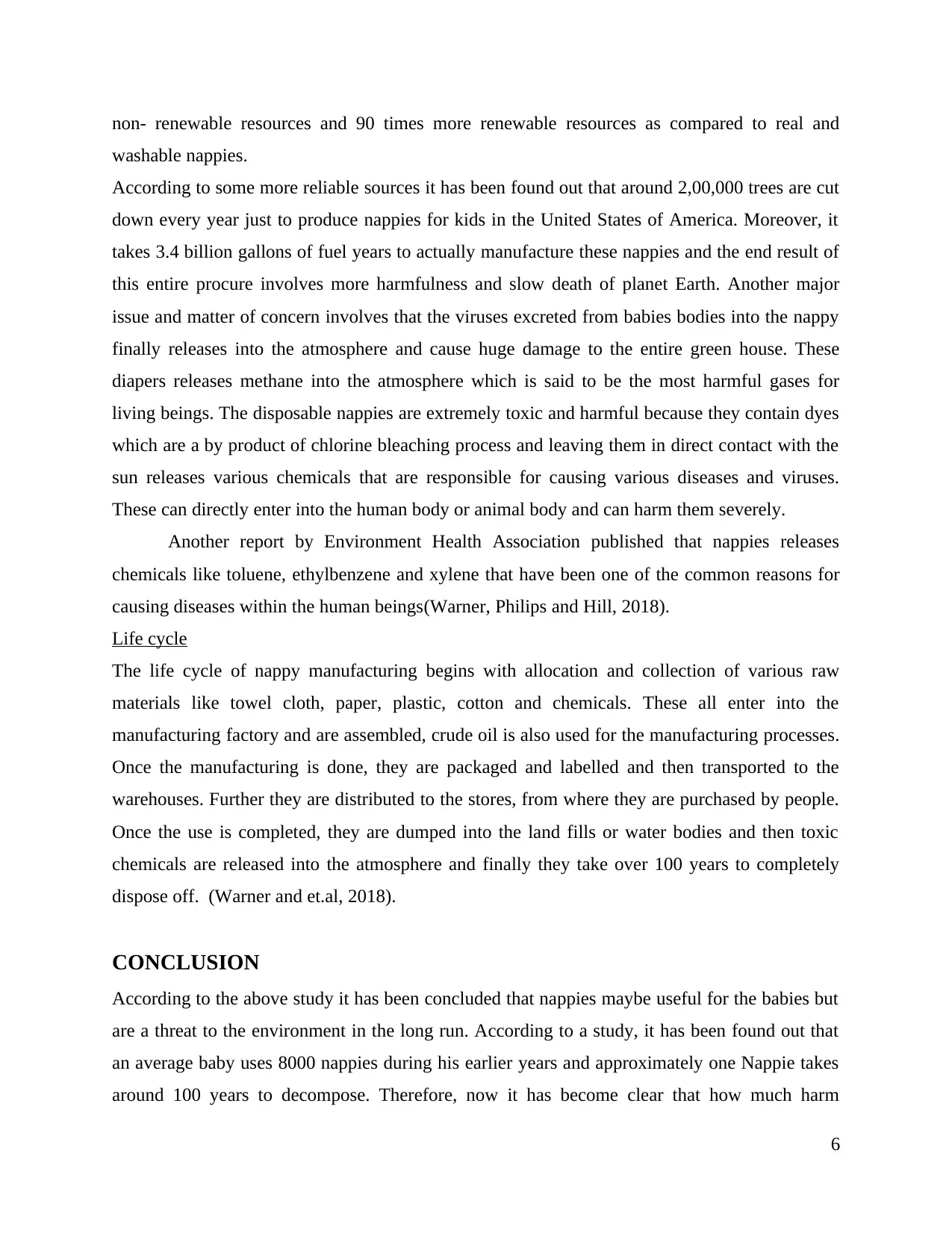
non- renewable resources and 90 times more renewable resources as compared to real and
washable nappies.
According to some more reliable sources it has been found out that around 2,00,000 trees are cut
down every year just to produce nappies for kids in the United States of America. Moreover, it
takes 3.4 billion gallons of fuel years to actually manufacture these nappies and the end result of
this entire procure involves more harmfulness and slow death of planet Earth. Another major
issue and matter of concern involves that the viruses excreted from babies bodies into the nappy
finally releases into the atmosphere and cause huge damage to the entire green house. These
diapers releases methane into the atmosphere which is said to be the most harmful gases for
living beings. The disposable nappies are extremely toxic and harmful because they contain dyes
which are a by product of chlorine bleaching process and leaving them in direct contact with the
sun releases various chemicals that are responsible for causing various diseases and viruses.
These can directly enter into the human body or animal body and can harm them severely.
Another report by Environment Health Association published that nappies releases
chemicals like toluene, ethylbenzene and xylene that have been one of the common reasons for
causing diseases within the human beings(Warner, Philips and Hill, 2018).
Life cycle
The life cycle of nappy manufacturing begins with allocation and collection of various raw
materials like towel cloth, paper, plastic, cotton and chemicals. These all enter into the
manufacturing factory and are assembled, crude oil is also used for the manufacturing processes.
Once the manufacturing is done, they are packaged and labelled and then transported to the
warehouses. Further they are distributed to the stores, from where they are purchased by people.
Once the use is completed, they are dumped into the land fills or water bodies and then toxic
chemicals are released into the atmosphere and finally they take over 100 years to completely
dispose off. (Warner and et.al, 2018).
CONCLUSION
According to the above study it has been concluded that nappies maybe useful for the babies but
are a threat to the environment in the long run. According to a study, it has been found out that
an average baby uses 8000 nappies during his earlier years and approximately one Nappie takes
around 100 years to decompose. Therefore, now it has become clear that how much harm
6
washable nappies.
According to some more reliable sources it has been found out that around 2,00,000 trees are cut
down every year just to produce nappies for kids in the United States of America. Moreover, it
takes 3.4 billion gallons of fuel years to actually manufacture these nappies and the end result of
this entire procure involves more harmfulness and slow death of planet Earth. Another major
issue and matter of concern involves that the viruses excreted from babies bodies into the nappy
finally releases into the atmosphere and cause huge damage to the entire green house. These
diapers releases methane into the atmosphere which is said to be the most harmful gases for
living beings. The disposable nappies are extremely toxic and harmful because they contain dyes
which are a by product of chlorine bleaching process and leaving them in direct contact with the
sun releases various chemicals that are responsible for causing various diseases and viruses.
These can directly enter into the human body or animal body and can harm them severely.
Another report by Environment Health Association published that nappies releases
chemicals like toluene, ethylbenzene and xylene that have been one of the common reasons for
causing diseases within the human beings(Warner, Philips and Hill, 2018).
Life cycle
The life cycle of nappy manufacturing begins with allocation and collection of various raw
materials like towel cloth, paper, plastic, cotton and chemicals. These all enter into the
manufacturing factory and are assembled, crude oil is also used for the manufacturing processes.
Once the manufacturing is done, they are packaged and labelled and then transported to the
warehouses. Further they are distributed to the stores, from where they are purchased by people.
Once the use is completed, they are dumped into the land fills or water bodies and then toxic
chemicals are released into the atmosphere and finally they take over 100 years to completely
dispose off. (Warner and et.al, 2018).
CONCLUSION
According to the above study it has been concluded that nappies maybe useful for the babies but
are a threat to the environment in the long run. According to a study, it has been found out that
an average baby uses 8000 nappies during his earlier years and approximately one Nappie takes
around 100 years to decompose. Therefore, now it has become clear that how much harm
6
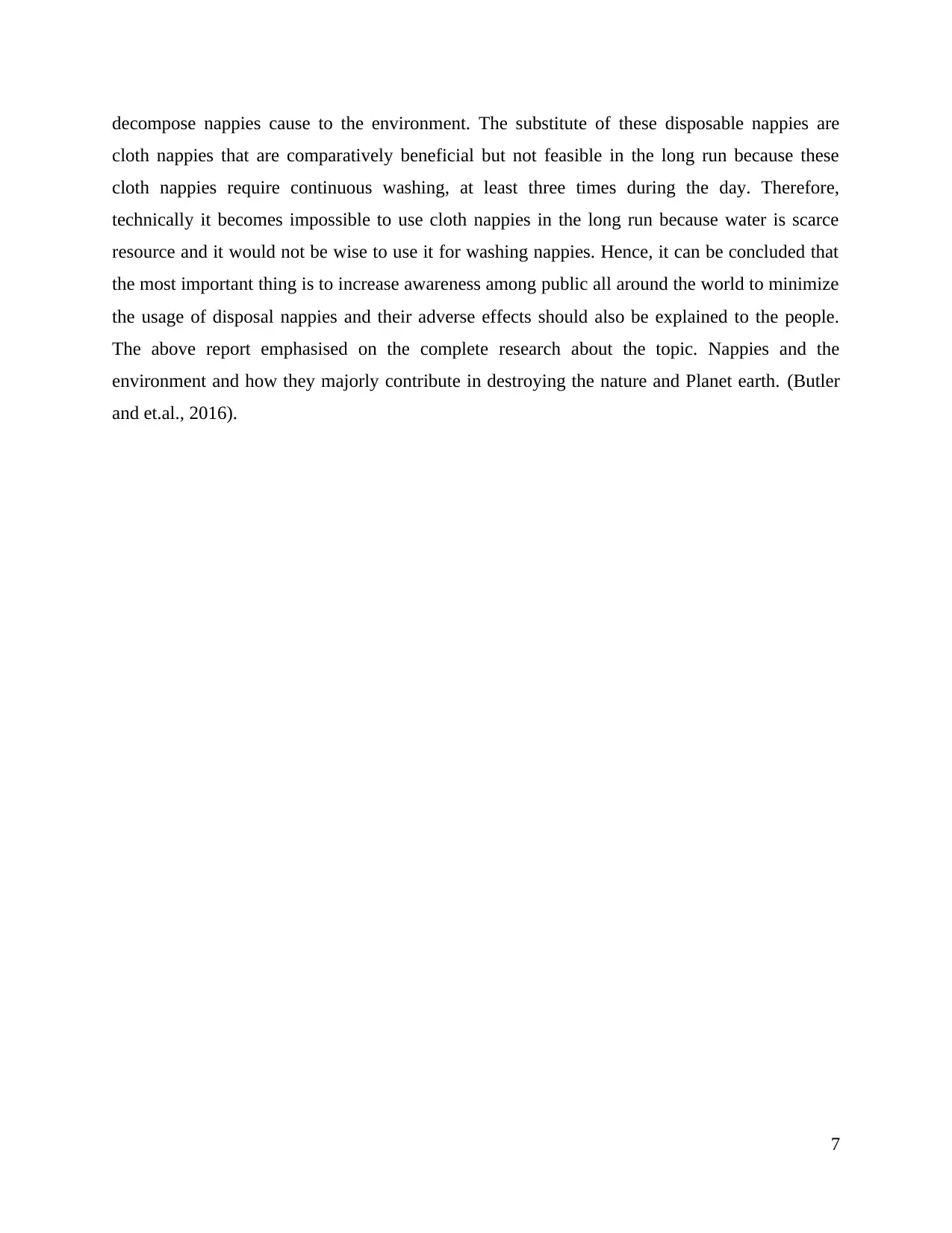
decompose nappies cause to the environment. The substitute of these disposable nappies are
cloth nappies that are comparatively beneficial but not feasible in the long run because these
cloth nappies require continuous washing, at least three times during the day. Therefore,
technically it becomes impossible to use cloth nappies in the long run because water is scarce
resource and it would not be wise to use it for washing nappies. Hence, it can be concluded that
the most important thing is to increase awareness among public all around the world to minimize
the usage of disposal nappies and their adverse effects should also be explained to the people.
The above report emphasised on the complete research about the topic. Nappies and the
environment and how they majorly contribute in destroying the nature and Planet earth. (Butler
and et.al., 2016).
7
cloth nappies that are comparatively beneficial but not feasible in the long run because these
cloth nappies require continuous washing, at least three times during the day. Therefore,
technically it becomes impossible to use cloth nappies in the long run because water is scarce
resource and it would not be wise to use it for washing nappies. Hence, it can be concluded that
the most important thing is to increase awareness among public all around the world to minimize
the usage of disposal nappies and their adverse effects should also be explained to the people.
The above report emphasised on the complete research about the topic. Nappies and the
environment and how they majorly contribute in destroying the nature and Planet earth. (Butler
and et.al., 2016).
7
⊘ This is a preview!⊘
Do you want full access?
Subscribe today to unlock all pages.

Trusted by 1+ million students worldwide
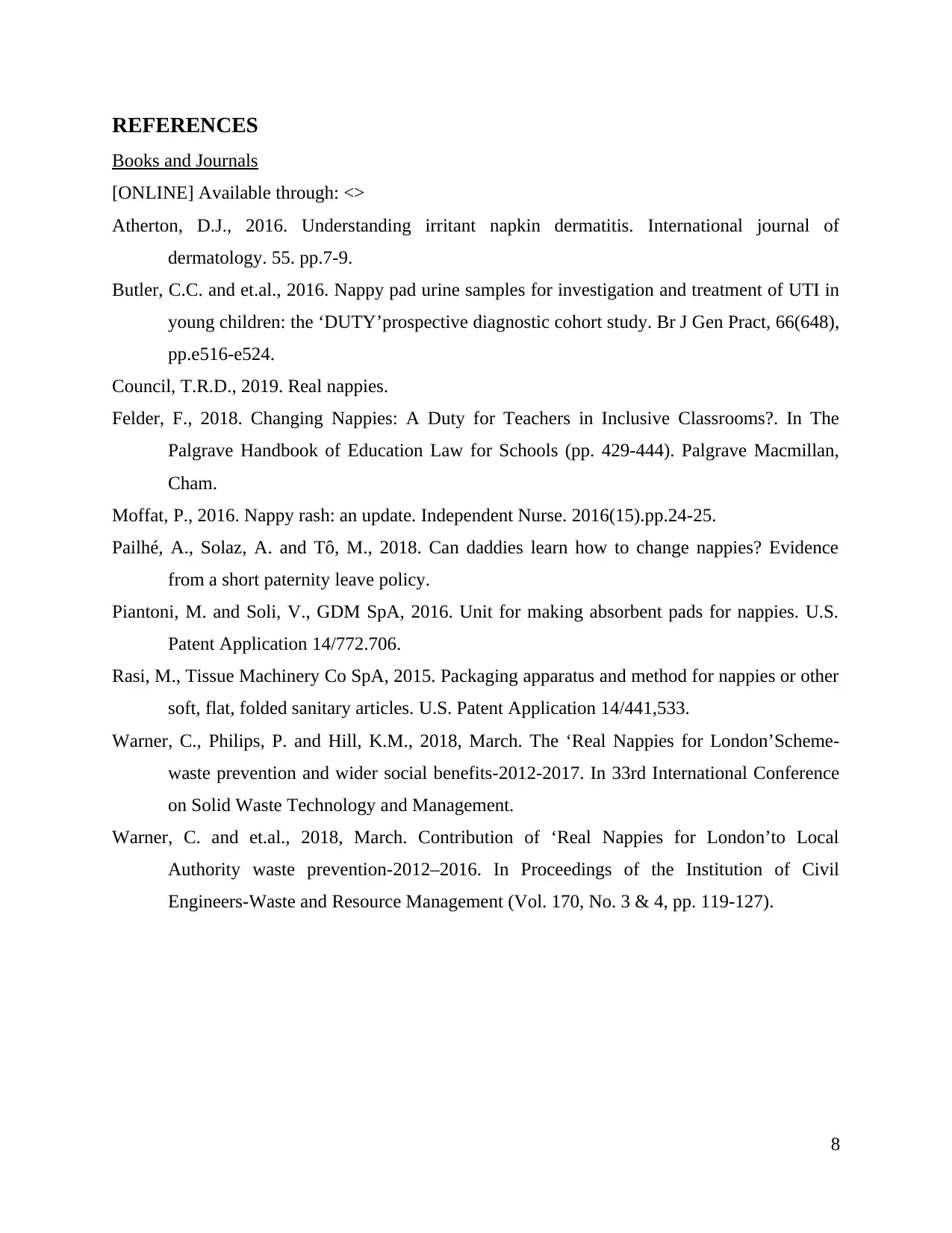
REFERENCES
Books and Journals
[ONLINE] Available through: <>
Atherton, D.J., 2016. Understanding irritant napkin dermatitis. International journal of
dermatology. 55. pp.7-9.
Butler, C.C. and et.al., 2016. Nappy pad urine samples for investigation and treatment of UTI in
young children: the ‘DUTY’prospective diagnostic cohort study. Br J Gen Pract, 66(648),
pp.e516-e524.
Council, T.R.D., 2019. Real nappies.
Felder, F., 2018. Changing Nappies: A Duty for Teachers in Inclusive Classrooms?. In The
Palgrave Handbook of Education Law for Schools (pp. 429-444). Palgrave Macmillan,
Cham.
Moffat, P., 2016. Nappy rash: an update. Independent Nurse. 2016(15).pp.24-25.
Pailhé, A., Solaz, A. and Tô, M., 2018. Can daddies learn how to change nappies? Evidence
from a short paternity leave policy.
Piantoni, M. and Soli, V., GDM SpA, 2016. Unit for making absorbent pads for nappies. U.S.
Patent Application 14/772.706.
Rasi, M., Tissue Machinery Co SpA, 2015. Packaging apparatus and method for nappies or other
soft, flat, folded sanitary articles. U.S. Patent Application 14/441,533.
Warner, C., Philips, P. and Hill, K.M., 2018, March. The ‘Real Nappies for London’Scheme-
waste prevention and wider social benefits-2012-2017. In 33rd International Conference
on Solid Waste Technology and Management.
Warner, C. and et.al., 2018, March. Contribution of ‘Real Nappies for London’to Local
Authority waste prevention-2012–2016. In Proceedings of the Institution of Civil
Engineers-Waste and Resource Management (Vol. 170, No. 3 & 4, pp. 119-127).
8
Books and Journals
[ONLINE] Available through: <>
Atherton, D.J., 2016. Understanding irritant napkin dermatitis. International journal of
dermatology. 55. pp.7-9.
Butler, C.C. and et.al., 2016. Nappy pad urine samples for investigation and treatment of UTI in
young children: the ‘DUTY’prospective diagnostic cohort study. Br J Gen Pract, 66(648),
pp.e516-e524.
Council, T.R.D., 2019. Real nappies.
Felder, F., 2018. Changing Nappies: A Duty for Teachers in Inclusive Classrooms?. In The
Palgrave Handbook of Education Law for Schools (pp. 429-444). Palgrave Macmillan,
Cham.
Moffat, P., 2016. Nappy rash: an update. Independent Nurse. 2016(15).pp.24-25.
Pailhé, A., Solaz, A. and Tô, M., 2018. Can daddies learn how to change nappies? Evidence
from a short paternity leave policy.
Piantoni, M. and Soli, V., GDM SpA, 2016. Unit for making absorbent pads for nappies. U.S.
Patent Application 14/772.706.
Rasi, M., Tissue Machinery Co SpA, 2015. Packaging apparatus and method for nappies or other
soft, flat, folded sanitary articles. U.S. Patent Application 14/441,533.
Warner, C., Philips, P. and Hill, K.M., 2018, March. The ‘Real Nappies for London’Scheme-
waste prevention and wider social benefits-2012-2017. In 33rd International Conference
on Solid Waste Technology and Management.
Warner, C. and et.al., 2018, March. Contribution of ‘Real Nappies for London’to Local
Authority waste prevention-2012–2016. In Proceedings of the Institution of Civil
Engineers-Waste and Resource Management (Vol. 170, No. 3 & 4, pp. 119-127).
8
1 out of 10
Related Documents
Your All-in-One AI-Powered Toolkit for Academic Success.
+13062052269
info@desklib.com
Available 24*7 on WhatsApp / Email
![[object Object]](/_next/static/media/star-bottom.7253800d.svg)
Unlock your academic potential
Copyright © 2020–2025 A2Z Services. All Rights Reserved. Developed and managed by ZUCOL.





